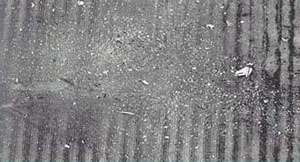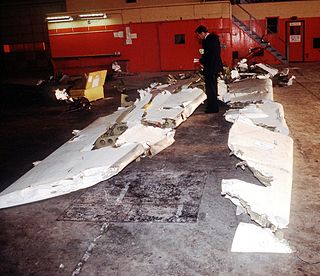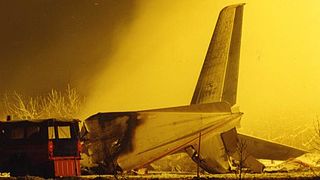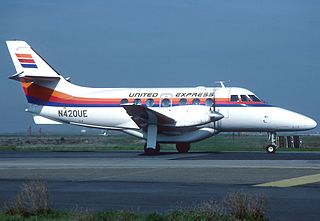 W
WThe 1946 Railway Air Services Dakota crash was the crash of a Douglas Dakota 3 of the British airline Railway Air Services 1 km north-east of Northolt Airport, London, United Kingdom on 19 December 1946. It was an unusual accident, considering that there were no fatalities under the circumstances.
 W
WOn 7 June 2017, a Shaanxi Y-8 aircraft of the Myanmar Air Force crashed on a flight from Myeik to Yangon, killing all 122 people on board. Debris from the aircraft was found in the Andaman Sea, 118 nautical miles (218 km) off Dawei by Myanmar Navy ships. It is the deadliest aviation accident in Myanmar's history.
 W
WAero Caribbean Flight 883 was a domestic scheduled passenger service from Port-au-Prince, Haiti to Havana, Cuba with a stopover in Santiago de Cuba. On 4 November 2010, the ATR 72 operating the route crashed in the central Cuban province of Sancti Spíritus, killing all 61 passengers and 7 crew members aboard.
 W
WAir Algérie Flight 5017 was a scheduled international passenger flight from Ouagadougou, Burkina Faso, to Algiers, Algeria, which crashed near Gossi, Mali, on 24 July 2014. The McDonnell Douglas MD-83 twinjet with 110 passengers and 6 crew on board, operated by Swiftair for Air Algérie, disappeared from radar about fifty minutes after take-off. There were no survivors.
 W
WAir Florida Flight 90 was a scheduled U.S. domestic passenger flight operated by Air Florida from Washington National Airport to Fort Lauderdale–Hollywood International Airport with an intermediate stopover at Tampa International Airport. On January 13, 1982, the Boeing 737-222 registered as N62AF crashed into the 14th Street Bridge over the Potomac River.
 W
WAir France Flight 447 was a scheduled international passenger flight from Rio de Janeiro, Brazil, to Paris, France. On 1 June 2009, the Airbus A330 serving the flight stalled and did not recover, eventually crashing into the Atlantic Ocean at 02:14 UTC, killing all 228 passengers and crew.
 W
WAir Ontario Flight 1363 was a scheduled Air Ontario passenger flight which crashed near Dryden, Ontario, on 10 March 1989 shortly after takeoff from Dryden Regional Airport. The aircraft was a Fokker F28-1000 Fellowship twin jet. It crashed after only 49 seconds because it was not able to attain sufficient altitude to clear the trees beyond the end of the runway, due to ice and snow on the wings.
 W
WAmerican Airlines Flight 63 was an American Airlines DC-3 nicknamed the Flagship Missouri that crashed on October 15, 1943, near Centerville, Tennessee, after ice formed on its wings and propeller. All eight passengers and three crewmembers perished. This was the second fatal crash of an aircraft designated Flight 63, occurring two-and-a-half months after the crash of the Flagship Missouri’s sister ship, the Flagship Ohio.
 W
WAmerican Eagle Flight 4184 was a scheduled domestic passenger flight from Indianapolis, Indiana to Chicago, Illinois, United States. On October 31, 1994, the ATR 72 performing this route flew into severe icing conditions, lost control and crashed into a field. All 68 people aboard were killed in the high-speed impact.
 W
WArrow Air Flight 1285 was a McDonnell Douglas DC-8 jetliner that operated as an international charter flight carrying U.S. troops from Cairo, Egypt, to their home base in Fort Campbell, Kentucky, via Cologne, West Germany, and Gander, Newfoundland.
 W
WBanat Air Flight 166 was an Antonov Antonov An-24 chartered on 13 December 1995 from Romavia by Banat Air.
 W
WBelavia Flight 1834 was a scheduled international passenger flight from Yerevan, Armenia, to Minsk, Belarus, operated by Belavia. On the morning of February 14, 2008, the Bombardier Canadair Regional Jet carrying 18 passengers and three crew crashed and burst into flames shortly after take off from Zvartnots International Airport near Yerevan, the capital of Armenia.
 W
WBraathens SAFE Flight 253, also known as the Hummelfjell Accident, occurred on 7 November 1956 at 9:50, when a de Havilland Heron crashed into Hummelfjell mountain in Tolga, Norway. The Braathens SAFE aircraft was en route from Trondheim Airport, Værnes to Oslo Airport, Fornebu. While passing Røros, the Heron started experiencing a rapid atmospheric icing which soon was too extensive for the ice protection system to handle. Combined with a downdraft, the aircraft lost sufficient lift to stay airborne. The pilots were able to turn the aircraft around, but it nevertheless hit Hummelfjell at an altitude of 1,350 meters (4,430 ft) above mean sea level.
 W
WCapital Airlines Flight 20 was a U.S. scheduled passenger flight from Washington, D.C. to Norfolk, Virginia. A Vickers Viscount flying the route crashed into a farm in Charles City County, Virginia, on January 18, 1960. The accident was the fourth fatal crash involving a Capital Viscount in less than two years; the first three were Capital Airlines Flight 67, Capital Airlines Flight 300 and Capital Airlines Flight 75. The plane was cruising at an altitude of 8,000 feet when it encountered icing. This caused two engines to fail. As the craft descended, the other two engines also failed, causing the propellers to autofeather. The crew tried and failed to restart the engines, and were unable to unfeather the propellers normally; they then put the plane into a dive in an attempt to force the propellers from their feathered position. Eventually they succeeded in restarting engine number four. They applied full power to this engine, which caused the craft to enter a circling descent until crashing into trees; at the time of impact it had almost no forward velocity. Five trees were driven through the fuselage, yet their trunks remained intact. The plane burned for hours after the crash, the police said at the time. They also indicated that they had not been able to approach it to make an effort at recovering bodies. In addition, treacherous underfooting made the use of firefighting equipment almost impossible. Heavy fog had closed many airports throughout eastern Virginia and had blanketed the area when the plane bearing 44 passengers and a crew of four came down on swampland near Sandy Gut, a tributary of the Chickahominy River about 30 miles southeast of Richmond. The plane was flying from Chicago to Norfolk - where the airport was open - by way of Washington. It had left Washington at 9:40 p.m. and crashed at 11 p.m. Capital Airlines in Washington identified the jet-prop aircraft's crew as Capt. James B. Fornasero, pilot; Philip Henry Cullom, first officer; and two hostesses, Diane Margaret O'Donnell and Brigitte Friede Helene Jordt.
 W
WCapital Airlines Flight 67 was a domestic scheduled passenger flight operated by Capital Airlines which crashed on final approach to Freeland, Michigan, USA, during a severe snowstorm on April 6, 1958. The flight was en route from Flint-Bishop Airport to the Freeland-Tri City Airport when it crashed. Flight 67 was the first of four fatal crashes in the space of two years involving Capital Airlines Vickers Viscounts; the others were Capital Airlines Flight 300, Capital Airlines Flight 75, and Capital Airlines Flight 20.
 W
WChina Eastern Airlines Flight 5210 (CES5210/MU5210), also known as the Baotou Air Disaster, was a flight from Baotou Erliban Airport in Inner Mongolia, China, to Shanghai Hongqiao International Airport, with a planned stopover at Beijing Capital International Airport. On 21 November 2004, just two minutes after takeoff, the Bombardier CRJ-200ER fell from the sky and crashed into a lake in Nanhai Park, next to the airport, killing all 53 people on board and two more on the ground.
 W
WComair Flight 3272 was a Comair flight from Cincinnati to Detroit on Thursday, January 9, 1997. While on approach for landing, the Embraer EMB 120 Brasilia aircraft crashed nose-down 18 miles (29 km) southwest of Detroit Metropolitan Wayne County Airport at 15:54 EST. All 29 aboard, 26 passengers and three crew members, were killed.
 W
WContinental Airlines Flight 1713 was a commercial airline flight that crashed while taking off in a snowstorm from Stapleton International Airport in Denver, Colorado on November 15, 1987. The Douglas DC-9 airliner, operated by Continental Airlines, was making a scheduled flight to Boise, Idaho. Twenty-five passengers and three crew members died in the crash.
 W
WOn 8 November 1940, a Deutsche Lufthansa Junkers Ju 90 passenger aircraft crashed near the municipality of Schönteichen, Germany, killing all 29 people on board.
 W
WOn January 9, 2011, Iran Air Flight 277, a Boeing 727 on a scheduled domestic service from Tehran to Urmia, Iran, crashed after aborting its approach into Urmia Airport in poor weather. Seventy-eight of the 105 people on board were killed. The official investigation concluded that icing conditions and incorrect engine management by the crew led to a double engine flame-out, loss of altitude and impact with the ground.
 W
WLinjeflyg Flight 618 was a crash of a Vickers 838 Viscount during approach to Stockholm Bromma Airport at 09:05 on 15 January 1977. All twenty-two people on board the aircraft perished when it hit ground at Kälvesta in Stockholm, Sweden. The domestic service from Malmö via Kristianstad, Växjö and Jönköping was operated by Skyline on behalf of Linjeflyg as part of the latter's domestic scheduled services. The accident was caused by atmospheric icing on the horizontal stabilizer. Low power on two of the engines had caused reduced function of the ice protection system, causing a buildup of ice. The icing caused the loss of pitch control and the aircraft entered a steep dive. Among the deceased was table tennis player Hans Alsér.
 W
WNorthwest Airlines Flight 5 was a regularly scheduled, multiple stop flight from Chicago Municipal Airport to Boeing Field, Seattle. It had intermediate stops at Minneapolis; Fargo, North Dakota; Billings, Montana; Butte, Montana; and Spokane, Washington. On October 30, 1941, on the flight's leg between Minneapolis and Fargo, the Northwest Airlines Douglas DC-3A-269 operating the route crashed into an open field about 2 1/2 miles east of the Fargo airfield, just after 2:00 am local time. All 12 passengers and two of the three crewmembers aboard were killed. The flight's captain Clarence Bates, the sole survivor, would end up dying himself a year later from another aviation accident in St. Paul, Minnesota.
 W
WPalair Macedonian Airlines Flight 301 was a scheduled international passenger flight to Switzerland's Zurich-Kloten Airport from Skopje International Airport, Skopje, which crashed shortly after take off on March 5, 1993. The Fokker 100 was operated by Palair, the then national airline of Macedonia.
 W
WRyan International Airlines Flight 590 was a cargo flight carrying mail for the United States Postal Service from Greater Buffalo International Airport (BUF) in Buffalo, New York, to Indianapolis International Airport (IND) in Indiana, with a stopover at Cleveland Hopkins International Airport (CLE) in Cleveland, Ohio. On February 17, 1991, the McDonnell Douglas DC-9-15RC operating the flight crashed on takeoff from Cleveland during icing conditions. Both pilots, the aircraft's only occupants, were killed. The National Transportation Safety Board (NTSB) determined that the causes of the crash were the flight crew failing to de-ice their aircraft, as well as the inexperience of the Federal Aviation Administration (FAA), McDonnell Douglas, and Ryan International Airlines with icing condition on DC-9-10 aircraft.
 W
WScandinavian Airlines Flight 751 was a regularly scheduled Scandinavian Airlines passenger flight from Stockholm, Sweden, to Warsaw, Poland, via Copenhagen, Denmark. On 27 December 1991, a McDonnell Douglas MD-81 operating the flight, registration OY-KHO, piloted by Danish Captain Stefan G. Rasmussen (44) and Swedish first officer Ulf Cedermark (34), both experienced pilots with 8,000 and 3,000 flight hours, respectively, was forced to make an emergency landing in a field near Gottröra, Sweden. Ice had collected on the wings' inner roots before takeoff, broke off, and was ingested into the engines as the aircraft became airborne on takeoff, ultimately resulting in the failure of both engines. All 129 passengers and crew aboard survived.
 W
WSol Líneas Aéreas Flight 5428 was a passenger flight which crashed near Los Menucos, Argentina, on 18 May 2011, killing all 22 people on board. The aircraft involved, a Saab 340, was operating Sol Líneas Aéreas' scheduled domestic service from Neuquén to Comodoro Rivadavia.
 W
WThe 1971 January 22 Surgut Aeroflot Antonov An-12 crash occurred on 22 January 1971, when an Aeroflot Antonov An-12B, registered CCCP-11000, flying from Omsk Tsentralny Airport, in the Soviet Union's Russian Soviet Federated Socialist Republic (RSFSR), crashed 15 km (9.3 mi) short of the runway on approach to Surgut International Airport, Surgut, RSFSR. An investigation found the aircraft's ice protection system was ineffective because the engine bleed air valves were closed during the flight; ice therefore built up on the aircraft causing it to go out of control.
 W
WThe 1971 January 31 Surgut Aeroflot Antonov An-12 crash occurred on 31 January 1971, when an Aeroflot Antonov An-12B, registered CCCP-12996, flying from Roshchino International Airport, Tyumen, in the Soviet Union's Russian Soviet Federated Socialist Republic (RSFSR), crashed 13.6 km (8.5 mi) short of the runway on approach to Surgut International Airport, Surgut, RSFSR. An investigation found the aircraft's loss of control was caused by icing.
 W
WTransAsia Airways Flight 791 was a regular cargo flight between Taiwan Taoyuan International Airport and Macau International Airport. At 01:52 AM local time on 21 December 2002, the ATR 72 operating the flight crashed into the sea 17 kilometres southwest of Magong, Penghu, Taiwan. The two crew members on board were killed.
 W
WThe 1974 Turkish Airlines Izmir crash occurred on January 26, 1974 when a Turkish Airlines Fokker F28-1000 Fellowship airliner, registration TC-JAO, named Van, on a domestic flight in Turkey from Izmir Cumaovası Airport (IZM) to Istanbul Yeşilköy Airport (IST/LTBA), stalled shortly after takeoff due to over-rotation and frost accretion on the wings, crashed, and caught fire.
 W
WTurkish Airlines Flight 5904 was a Boeing 737-400 on an international repositioning flight from Adana Şakirpaşa Airport in Adana, Turkey to King Abdulaziz International Airport in Jeddah, Saudi Arabia which crashed on 7 April 1999 in the vicinity of Ceyhan, Adana Province in southern Turkey some eight minutes after takeoff. The flight was on its way to Saudi Arabia to pick up pilgrims from Jeddah, and as such took off without any passengers on board. All six crew members were killed in the crash.
 W
WUnited Express Flight 2415 was a regularly scheduled flight from Seattle to Pasco, Washington, operated using a BAe Jetstream 31. On December 26, 1989, Flight 2415 crashed while attempting to land at Pasco's Tri-Cities Airport, killing both pilots and all four passengers aboard.
 W
WUSAir Flight 405 was a regularly scheduled domestic passenger flight between LaGuardia Airport in Queens, New York City, New York, and Cleveland, Ohio. On March 22, 1992, a USAir Fokker F28, registration N485US, flying the route, crashed in poor weather in a partially inverted position in Flushing Bay, shortly after liftoff from LaGuardia. The undercarriage lifted off from the runway, but the airplane failed to gain lift, flying only several meters above the ground. The aircraft then veered off the runway and hit several obstructions before coming to rest in Flushing Bay, just beyond the end of the runway. Of the 51 people on board, 27 were killed, including the captain and a member of the cabin crew.
 W
WWest Caribbean Airways Flight 708 was a West Caribbean Airways charter flight that crashed in a mountainous region in northwest Venezuela in the early hours of Tuesday, 16 August 2005, killing all 160 passengers and crew on board. The plane, a McDonnell Douglas MD-82, registration HK-4374X, was en route from Tocumen International Airport (PTY) in Panama City, Panama, to Martinique Aimé Césaire International Airport (FDF) in Fort-de-France, Martinique, France. While flying at 33,000 ft (10,000 m), the aircraft's speed gradually decreased until it entered an aerodynamic stall. The crew, probably under the mistaken belief that the aircraft had suffered a double engine flame-out, did not take the necessary actions to recover from the stall. The confusion and lack of action resulted in the crash.
 W
WWorld Airways Flight 30 was a McDonnell Douglas DC-10-30CF airliner which suffered a fatal accident upon landing at Boston Logan International Airport in Boston after departing Newark International Airport in Newark, New Jersey on January 23, 1982. Two of the passengers were never found, and are presumed to have drowned.
 W
WXL Airways Germany Flight 888T (GXL888T) was an Airbus A320 that crashed into the Mediterranean Sea, 7 km off Canet-en-Roussillon on the French coast, close to the Spanish border, on 27 November 2008, killing all seven people on board.